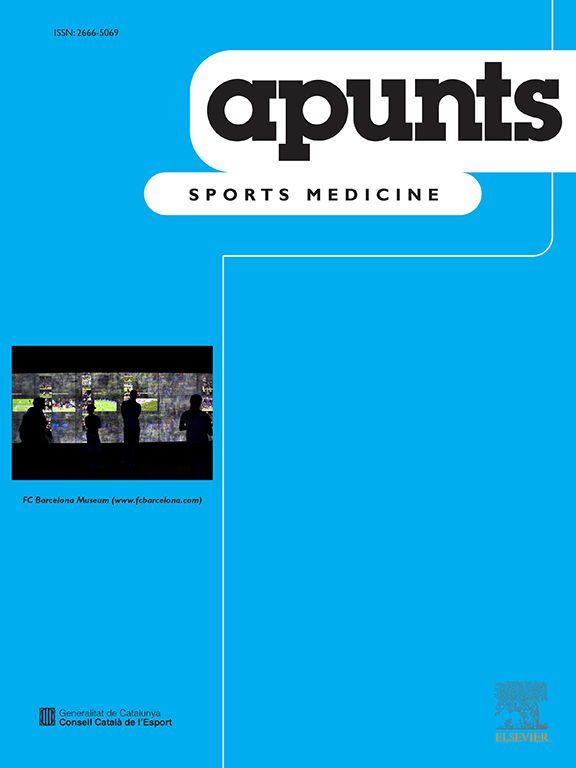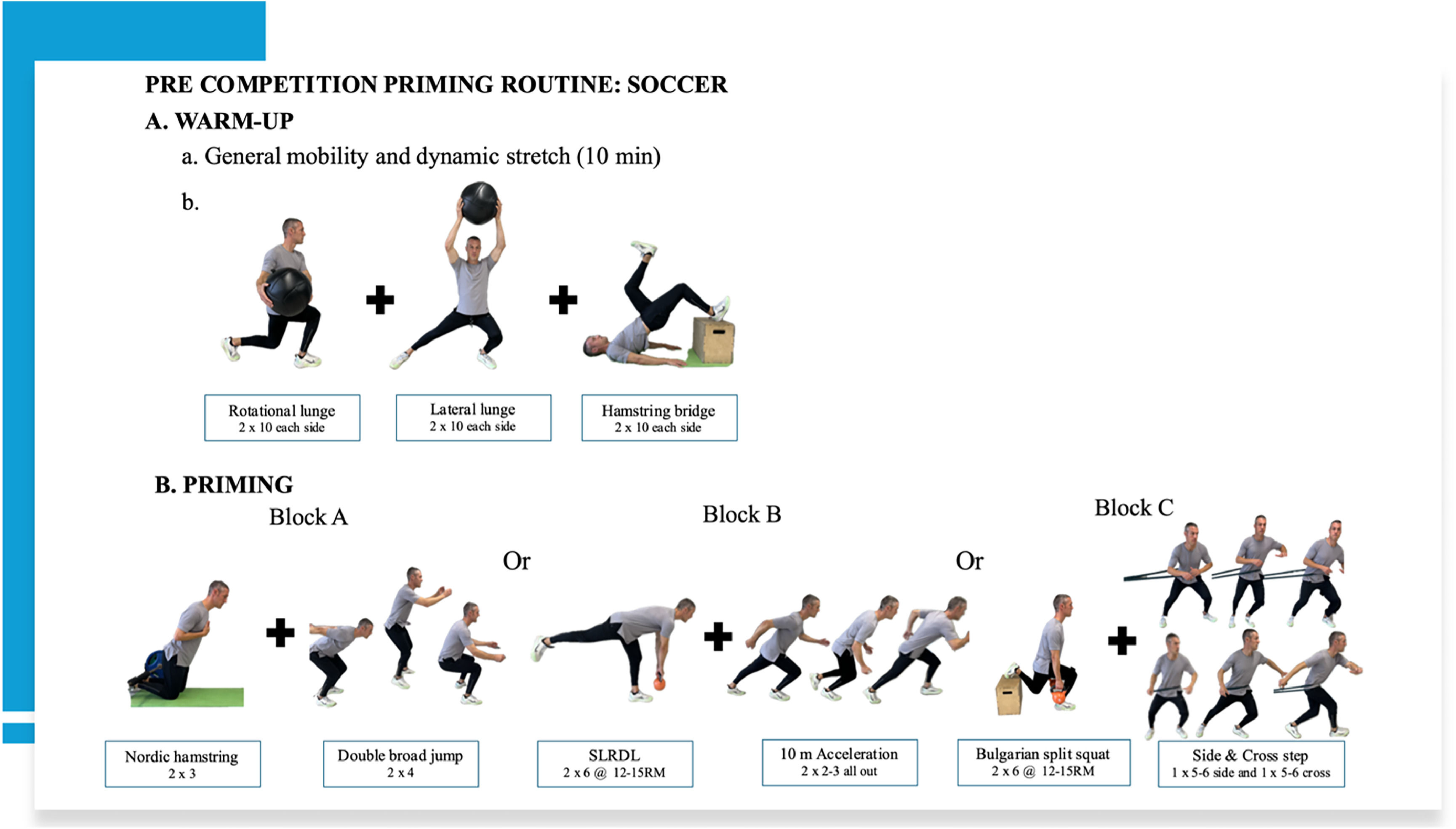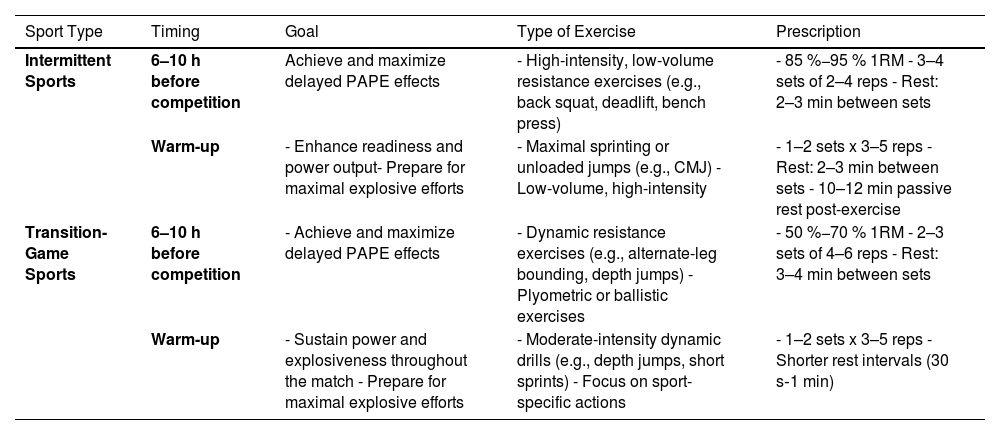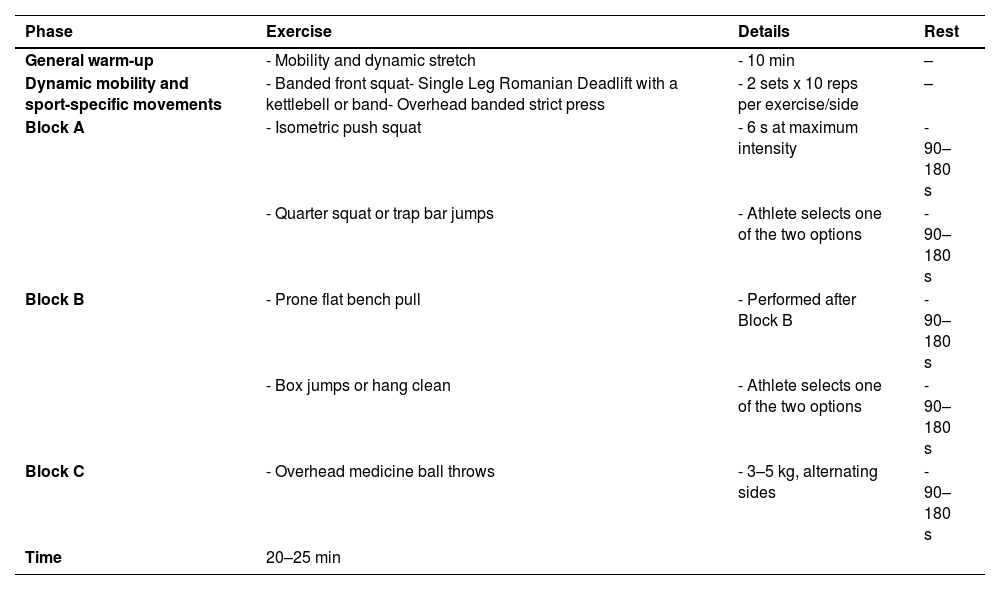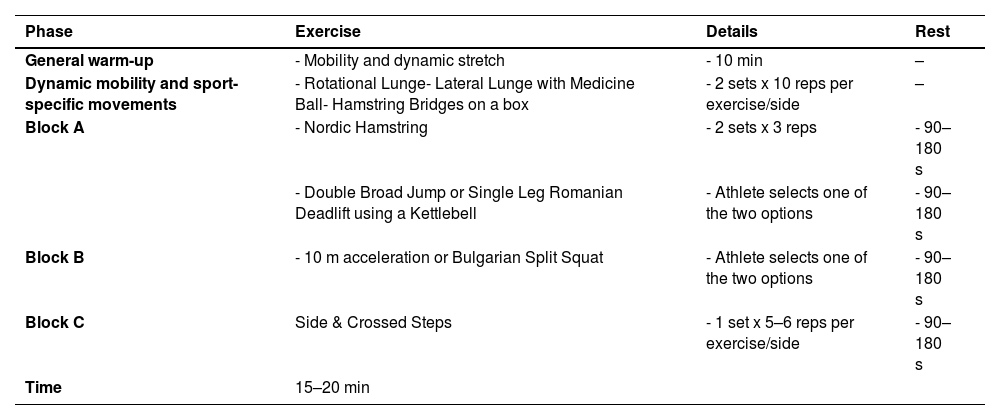Exercise-based priming has emerged as a valuable pre-competition strategy to enhance neuromuscular readiness, acute physical performance, and potentially reduce injury risk in team sport athletes. While the scientific rationale for priming is increasingly well-documented, there remains a need to translate these findings into actionable frameworks. This article aims to provide staff members and practitioners with evidence-informed, practical guidelines for implementing priming protocols before the competition. The proposals are tailored to the intermittent and multidirectional nature of team sports, with a focus on enhancing key explosive actions such as sprinting, jumping, and changes of direction. Importantly, the guidelines consider factors such as timing, exercise selection, and intensity to support both performance optimization and the prevention of musculoskeletal injuries. By bridging scientific evidence with practical application, this paper facilitates the safe and effective integration of priming strategies into pre-competition routines within team sport environments.
The quest for peak performance in sports often drives athletes and practitioners to seek new knowledge1 that can generate a competitive advantage, especially in elite sports where thorough preparation is essential to achieve success. That is why exercise-based priming has lately earned attention from the sports science community. This method serves as an advanced or potentiated warm-up, involving exercises designed to activate the neuromuscular system, thereby enhancing both physical readiness2 and mental focus3 before competitive events. A shared challenge across team sports is the demand for athletes to perform at their best from the very start of each game, period, or half. In this context, exercise-based priming emerges as a valuable tool, supported by research demonstrating its effectiveness in enhancing athletes' readiness for competition.4,5
The physical demands of each team sport play a critical role in shaping the design of priming strategies (PS), which must balance a general rationale with sport-specific adaptations. According to the taxonomy outlined by Gambetta,6 intermittent-sprint sports such as American football, ice hockey, and volleyball prioritize maximizing power and explosiveness, with relatively complete recovery between high-intensity efforts. In contrast, transition-game sports, such as soccer, rugby, field hockey, handball, and basketball, are characterized by unpredictable sequences of high- and low-intensity actions, with recovery periods ranging from minimal to nearly complete. Consequently, the exercises, application timing, and strategies used in priming must be carefully tailored to meet the unique demands of each discipline. Despite these distinctions, all these sports share a reliance on repeated speed and power actions, including sprints,7 jumps,8 and changes of direction.9
PS are considered effective primarily due to their potentiation effect on subsequent performance actions.2 Post-activation potentiation (PAP) is often cited as a key mechanism underlying the enhanced ability to execute exercises under improved conditions. Exercise-based priming, however, extends beyond traditional PAP by increasing the rate of force development during high-speed dynamic contractions and maintaining its effects for a longer duration—typically several minutes—following the initial exercise. Consequently, to ensure that practitioners apply methods grounded in accurate underlying mechanisms, the concept of post-activation performance enhancement (PAPE) was established.10 PAPE differs from PAP by encompassing broader mechanisms, including neural drive and muscle temperature, beyond PAP's focus on muscular phosphorylation. Additionally, PAPE has a longer activation window, making it more practical for real-world sports applications. This sustained impact is attributed to physiological responses such as elevated muscle temperature, intracellular water accumulation, and other related mechanisms.11 Additionally, the neuromuscular and physiological effects of priming include hormonal shifts and heightened neuromuscular activation, which collectively contribute to improved strength, power, and overall readiness for competition.2
PS can be classified into three categories based on their timing relative to competition:
- 1.
Prior Priming Exercises: These are conducted more than three hours before competition and typically involve resistance or sprint-based exercises designed to enhance neuromuscular performance. Low-volume power training, such as 5 sets of 4 jumps at 40 % 1RM, yields delayed benefits in explosive muscle performance 24 h post-training.12 Resistance exercises, whether high-load (≥85 % 1RM) or low-load (30–40 % 1RM), are particularly effective when performed 6–33 h before competition.2 Additionally, heavy-load resistance training enhances strength and power following a 4–6 hour recovery period,13 while sprint-based priming improves both sprint and repeated sprint performance after 5–6 h.14
- 2.
Modified Warm-Ups: Conducted within three hours of competition, these often leverage post-activation performance enhancement (PAPE) protocols. For example, a single set of 5 back squats at 85 % 1RM, followed by 12 min of rest, significantly improved jump height, agility, and speed.15 Progressive warm-ups, incorporating incremental loads for back squats and deadlifts, have also demonstrated potentiation effects on repeated jump performance.16
- 3.
In-Game Priming: Performed during breaks, such as halftime, these strategies aim to maintain neuromuscular readiness. Silva et al.17 suggested combining heated garments with explosive activities, such as sprints, jumps, or ball drills, for five minutes to preserve muscle temperature and enhance performance compared to passive rest. Similarly, Yanaoka et al.18 found that a 1-minute high-intensity warm-up at 90 % VO2 max helped sustain sprint performance and muscle strength while improving core temperature and heart rate in team sports players during soccer-specific testing.19
A variety of exercise-based strategies have been explored to enhance physical performance and athlete readiness, with effectiveness depending on factors like exercise selection, intensity, volume, equipment, and recovery intervals. Resistance exercises using compound movements, such as squats and power cleans, are generally more effective than isolated movements like leg extensions, as they stress the entire system rather than specific muscles.20–22 Examples include low-volume back squats paired with power cleans22 or combinations of sprints with upper- and lower-body resistance exercises.23 Running-based interventions,13 cycling,24 and sled training25 have also demonstrated benefits for sprinting, jumping, and power outputs. For resistance training, both heavy and light loads can be effective. Loturco et al.26 found similar improvements in jump height, sprint speed, and change of direction (COD) using jump squats (JS) with loads of 40 % and 85 % 1RM, though lighter loads caused less fatigue and enhanced peak velocity 24 h post-exercise. Similarly, West et al.27 demonstrated that ballistic bench throws at 30 % of 1RM and heavy bench presses at 87 % of 1RM had comparable effects on upper-body power after 8 min of recovery. Isometric exercises are gaining attention for their priming effects. Submaximal isometric squats at 75 % of 1RM for 4 s increased countermovement jump (CMJ) height, with results comparable to isotonic squats.28 Females also experienced jump height gains with 5-second isometric back squats using an immovable bar.29 Elastic resistance is another accessible option, as Kcrmar et al.30 found that improved sprint times and squat jump (SJ) heights can be achieved using elastic bands that provide 30–40 % resistance alongside traditional weights. Other modalities include occlusion training, flywheel protocols, and whole-body vibration (WBV). Occlusion exercises31,32 have improved jump height and running performance, while flywheel protocols have demonstrated superior jump performance compared to guided barbell squats. WBV enhanced vertical jump height and muscle power immediately after application.33,34 Tasks using the stretch-shortening cycle (SSC) require careful consideration. While depth jumps (DepthJ) performed shortly before maximal strength tests improved performance,35 rebound jumps until exhaustion caused prolonged decrements in SJ and drop jump (DJ) metrics.36 This highlights the importance of tailoring SSC exercises and timing to minimize fatigue and optimize performance outcomes.
Beyond optimizing performance, exercise-based priming may play a crucial role in injury prevention, particularly in team sports where athletes are required to perform explosive movements and high-intensity actions from the onset of competition. Priming strategies often involve dynamic, high-intensity neuromuscular activation exercises that enhance muscle temperature, improve motor unit recruitment, and increase tissue extensibility, which collectively contribute to joint stability and proprioceptive awareness37 These physiological adaptations are central to reducing the risk of non-contact musculoskeletal injuries, such as anterior cruciate ligament (ACL) tears, hamstring strains, and ankle sprains—injuries prevalent in multidirectional and high-speed sports.
In fact, neuromuscular training programs, which share several principles with priming routines, including progressive dynamic activation, core stabilization, and postural control, have consistently demonstrated efficacy in reducing the incidence of lower limb injuries. Several systematic reviews have reported that well-designed neuromuscular interventions can decrease the risk of injury by around 50 % in youth and adult team sport athletes.37–41 More recent evidence has further emphasized the effectiveness of warm-up protocols, integrating agility drills, plyometrics, and movement control exercises—elements often embedded within priming strategies—on injury prevention.42
In addition, priming may have acute prophylactic effects by modulating corticospinal excitability43 and promoting more efficient neuromuscular recruitment patterns during early phases of competition.44 This is particularly relevant during congested fixture periods, when residual fatigue and neuromuscular inhibition may increase the risk of injury. When appropriately designed, priming can act as a neuromuscular buffer against this cumulative fatigue, helping athletes maintain optimal motor control and load absorption mechanics.45
Taken together, these findings suggest that integrating priming exercises into pre-competition routines is not only beneficial for immediate performance enhancement but also serves as a science-based strategy to mitigate injury risk in both training and competitive contexts. This dual benefit underlines the need for sport scientists and practitioners to consider priming as part of comprehensive warm-up and load management strategies.
Coaches and practitioners are encouraged to integrate these strategies based on timing, specific performance demands, construct validity, and balancing exercise selection and intensity to maximize priming and preventive benefits.
Practical strategies for implementing effective priming sessions in team sportsDespite the growing body of evidence supporting the benefits of exercise-based priming for enhancing athletic performance, practical application in team sports remains a challenge for many practitioners. Factors such as limited preparation time, logistical constraints, and the unique demands of intermittent and transition-game sports often hinder the effective integration of priming strategies into competition routines.
In this section, we present a practical framework designed to bridge the gap between scientific research and on-field implementation. Our proposal outlines specific priming protocols tailored to the physiological and tactical requirements of team sports, with an emphasis on feasibility, adaptability, and performance optimization. By focusing on methods that strike a balance between effectiveness and accessibility, we aim to provide coaches with actionable solutions to enhance readiness and maximize the explosive actions essential for success in these sports.
TimelineIntegrating post-activation potentiation (PAP) within a competitive team's routine requires careful planning to align with the demands of competition. One of the most effective approaches involves a two-session strategy followed by a specific pre-game warm-up.
The first physical training session, conducted 20–24 h before the competition, is strategically designed to stimulate the activity of fast-twitch muscle fibers (types IIa and IIX).46 These fibers are critical for explosive, high-intensity movements required in competition, such as sprinting, jumping, and rapid directional changes. The session prioritizes a combination of heavy resistance training and explosive movements to achieve its goals. We summarize the broad general guidelines in Fig. 1.
The second session should be scheduled on competition day, ideally 6 to 10 h before the event. This priming session emphasizes highly specific, minimally fatiguing exercises tailored to optimize performance without overloading the athletes. Alternatively, for competitive events scheduled early in the morning, this session can be conducted at the end of the previous day of preparation. Detailed exercise recommendations for these sessions are provided in Table 1. This structured timeline ensures athletes are primed for peak performance while minimizing the risk of fatigue. In all our proposals, we distinguish between families of team sports, as their inherent characteristics, in our view, require slightly tailored approaches. For better fatigue management, linear transducers or devices intended for velocity-based training (such as wearables, smartphones, accelerometers, etc.) can be used with those exercises that due to its eminently linear trajectory and little cosine error allow it, limiting average propulsive velocity losses to 10–15 % in all exercises,47 with few sets and repetitions for each task.
Characteristics, objectives, examples, and exercises prescribed for sessions scheduled on competition day and pre-game warm-ups.
In team sports, such as soccer, pre-game warm-ups typically last between 15 and 45 min, with an average duration of around 30 min.48 Emerging evidence supports the use of shorter and more intense warm-ups (10–15 min) as equally effective for enhancing performance while limiting energy depletion.49 Findings suggest that optimizing warm-up length is key to balancing readiness and fatigue.50 Thus, to follow this direction, we suggest shorter pre-game warm-ups that may include tasks similar to those described in Table 1 to ensure apparent PAPE effects on subsequent actions, particularly benefiting starting players or those expected to play the most minutes in the initial phases of the competition. The effectiveness of this type of practice in improving performance51 and preventing sports injuries is widely demonstrated.52–54
PS for different types of sportsBuilding on the principles outlined earlier, we now present two practical proposals for implementing pre-game warm-up PS in team sports, specifically tailored to intermittent and transition-game sports. These proposals account for the distinct physical and tactical demands of each sport type, emphasizing the importance of sport-specific adaptations to maximize performance benefits. a. Intermittent Sports
Intermittent sports are defined by repeated high-intensity actions such as sprints, jumps, and changes of direction, interspersed with complete recovery periods. These sports demand a well-prepared neuromuscular system to execute explosive movements effectively throughout the game. As such, priming strategies in these contexts aim to enhance power output through PAPE while minimizing fatigue.
Effective PS for intermittent sports should include high-intensity, low-volume exercises designed to elevate body temperature, improve physiological readiness, and optimize neuromuscular activation. For example, volleyball—a sport that heavily relies on lower-body power for jumping and upper-body power for actions like serving or spiking55 —benefits from tailored PS routines. These routines can incorporate power-focused movements, such as Olympic lifts and their derivatives, to enhance performance without inducing excessive fatigue.
The example in Fig. 2 illustrates a volleyball-specific PS protocol, where exercises are adjusted based on individual characteristics such as 1RM percentages or personal bests (PBs). To further refine the approach, integrating technological tools to monitor athlete readiness and fatigue levels can provide valuable insights and ensure optimal results.
The proposed priming protocol, detailed in Table 2, is designed to optimize neuromuscular activation and performance readiness through a structured series of exercises. Following a general and sport-specific warm-up, the protocol transitions into Block A, which incorporates high-intensity and explosive movements that target key muscle groups. The protocol allows for some exercise variation, enabling athletes to choose between options such as quarter squats or trap bar jumps, box jumps, or hang cleans, to suit their individual needs. With a total duration of 20–25 min and rest intervals of 90–180 s, this protocol offers an efficient and adaptable approach to priming for competition. b. Transition-Game Sports
Priming protocol sequence for intermittent team sports, including exercise options and rest intervals.
Transition-game sports are characterized by variable-intensity efforts occurring in unpredictable patterns throughout the game. These sports demand a combination of explosive power and sustained endurance to maintain performance under dynamic conditions. As a result, effective PS strategies must address both short-term power output and the ability to sustain high-intensity efforts over time.
Priming for transition-game sports should focus on dynamic conditioning exercises that replicate the movement patterns and energy demands of the sport. These activities aim to enhance neuromuscular readiness and achieve a PAPE effect tailored to the sustained and varied demands of gameplay.
For instance, the PS example in Fig. 3, designed for soccer, incorporates exercises requiring minimal specialized equipment, making it suitable for on-field implementation.
This routine, detailed in Table 3, includes bodyweight movements, small-weight exercises, and resistance work using elastic bands. Reflecting the specific demands of soccer, the program emphasizes horizontal vector exercises, multi-axial movements, and acceleration drills. Additionally, it targets key muscle groups, such as the hamstrings,56 which endure substantial stress during competition, to enhance performance and mitigate injury risk.57,58
Priming protocol sequence for transition-game sports, with exercise options and rest intervals.
Team sports typically have scheduled game breaks, such as halftime or between periods. Thus, practitioners may be encouraged to effectively use this time to maintain or improve performance for the remaining competition. In-game priming may help maintain optimal physical and psychological readiness during breaks, such as the mentioned halftime or timeouts. Although re-warm-up protocols, if any, have primarily aimed at minimizing temperature declines using active59–61 (e.g., 7–8 min of running at 70 % of HRmax) or passive62 (i.e., using heated garments) strategies, using specifically tailored exercises as a PS may also be adequate to this end. Thus, incorporating low-volume activities, such as short sprints, medicine ball throws, unloaded jumps, resisted accelerations, COD, and task-specific drills that do not generate a high level of fatigue that may compromise the athlete, while aiming to maintain muscle activation, body temperature, and heart rate, may ensure athletes return to activity at peak capacity.63,64 A typical protocol includes short sprints of 10 to 20 m performed in 1 set of 4 to 6 repetitions, with 20 to 30 s of rest between efforts. This can be complemented by a set of 8 to 10 unloaded jumps, such as vertical jumps, bounding, or depth jumps, with brief rest intervals of 15 to 20 s, aimed at enhancing explosive lower-limb power. Additionally, small-sided games lasting 3 to 5 min can be used to simulate game-specific intensities. These drills should involve ball handling, short passes, and multidirectional movements that replicate the demands of play, offering both physiological and tactical readiness in a contextualized manner. The positive effects of this re-warm-up on performance51,65 and injury prevention66 have also been demonstrated in the literature. Incorporating exercises of this nature immediately before substitutions, when allowed by the sport's dynamics or the competitive context, can also be advantageous. This scenario is common in field sports such as soccer, where players are typically required to warm up shortly before stepping onto the field.
Because the demands of intermittent and transition-game team sports differ, exercise-based priming strategies may need to be adjusted. Transition-game sports rely more on repeated efforts with unspecified rest periods, while intermittent sports focus on maximizing power output during specific actions. Therefore, the proposed priming protocols should vary not only in their timing relative to competitions and the logistical considerations of their application, but also in the specific sport context for which they are designed.
ConclusionExercise-based priming is an effective strategy to enhance neuromuscular readiness, optimize performance from the outset of competition, and reduce the risk of musculoskeletal injuries in team sports. Its implementation enables athletes to maximize explosive actions, maintain high performance levels, and minimize fatigue, ultimately offering a significant competitive advantage. A structured approach that combines physical training sessions with sport-specific, individualized protocols is an effective strategy for better preparing for high-demanding scenarios. In intermittent sports, high-intensity, low-volume exercises are recommended in these sessions. In transition-game sports, dynamic conditioning drills that replicate movement patterns and energy demands are more suitable. Exercise selection should prioritize specificity, construct validity, and alignment with performance goals, while also considering the risk of low injury. Technological tools or training monitoring systems can help ensure appropriate intensity and volume, preventing overtraining and enhancing the benefits of priming. Incorporating priming stimuli, such as maximal sprints or unloaded jumps, into pre-game warm-ups elicits PAPE, also contributes to improved functional readiness, thereby enhancing immediate performance and potentially reducing the incidence of injuries during competition.
FundingThis research did not receive any specific grant from funding agencies in the public, commercial, or not-for-profit sectors.
The authors declare no conflicts of interest.

